Benson’s latest release, the 12-song Guitar Man, showcases more 6-string slinging than many of his previous releases. “That title was a way to let people know there would be more guitar on this record than they’ve been hearing in the recent past,” says Benson. Among the album’s highlights are tributes to two of the jazz icon’s guitar idols. “Tequila” tips the hat to Wes Montgomery, while “I Want to Hold Your Hand” is a nod to Grant Green rather than the Beatles. But though Guitar Man features plenty of guitar, it’s not quite as over-the-top as the pyrotechnic-laden classics from 1974’s Bad Benson. This latest effort is more refined and has about just as much guitar as a successful commercial album would allow, as evidenced by the fact that Guitar Man reached No. 1 on the Billboard jazz charts a few weeks after its release.
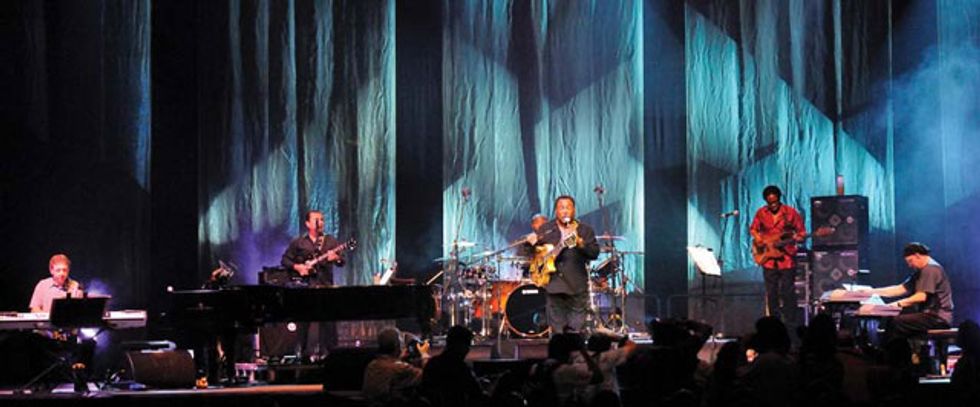 Photo courtesy William “Billy” Heaslip
Photo courtesy William “Billy” HeaslipWe caught up with the smooth operator to discuss the new album, his gear, and his unique picking technique—which has long been a hot topic among the hordes of Benson wannabes.
You played a lot of acoustic
guitar on Guitar Man.
Yeah, we used two different kinds
of acoustics—a Yamaha and a
Cordoba. They aren’t very expensive,
but they sounded good.
Did you use any of your
signature electrics?
Oh yeah, definitely. I used
the Ibanez GB30 and also a
D’Angelico that I had in the
closet. I only take that out on
special occasions. I got a lot of
my hit records with that guitar.
Do you roll the tone knob
down or do you keep it all
the way up?
I have both the tone and volume
controls basically all the
way up. Something happens to
the tone when I back up off the
volume—I like to feel the bite
of the guitar. Y’know, feel all
the openness.
Some jazz cats feel like a lot
of that bite has to do with
strings. Are you pretty particular
about yours?
If I’m on the road, I like to use
.012s. If I’m recording, I like to
use .014s—I can hear more and
dig in more with the .014s. On
the road, I can’t really hear all
that because it goes past me and
out into the audience.
Can you play as fast on the
.014s as you do on the .012s?
Yeah, I think so. I never
thought about that. I better
put that to the test before I say
“yes.” [Laughs.]
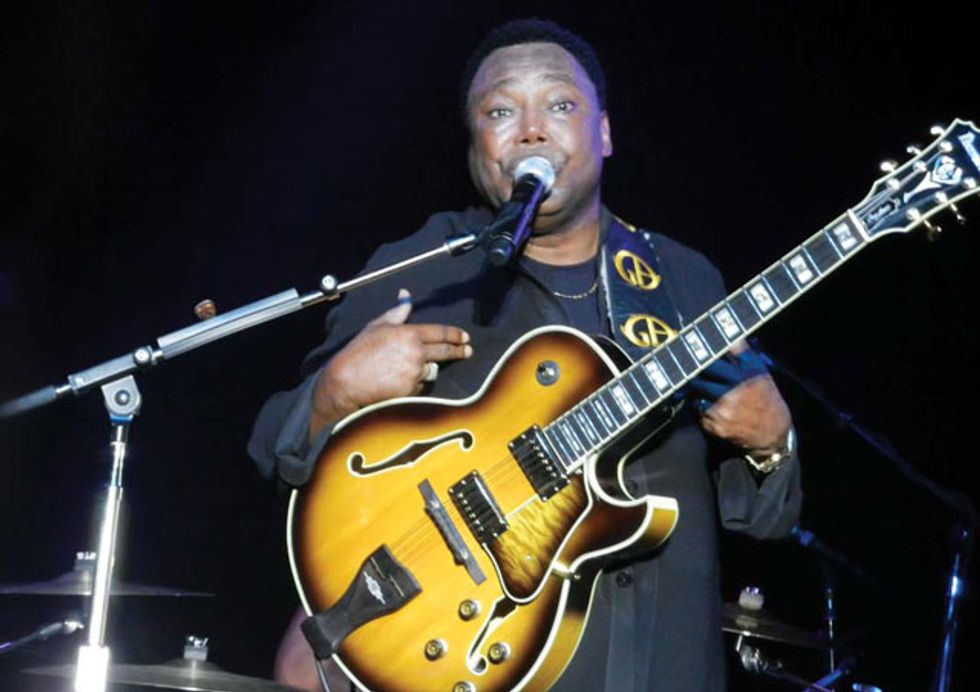 Photo by Jerry L. Neff
Photo by Jerry L. NeffHave you tried any other
Ibanez jazz guitars, like the
Pat Metheny model?
I’ve tried a couple of those and
some of them were good, but
mine is designed with my needs
in mind. I don’t like feedback,
and I don’t like thin sounds. I
want a full sound but I don’t
want to worry about muting
the strings because they’re
feeding back. My GB10 is
unique because it has a smaller
body, which takes care of a lot
of the feedback issues.
You recently auctioned off
some instruments you owned
that originally belonged to
some pretty famous people.
Yes. Pat Metheny bought Wes
Montgomery’s L5 at auction. I
didn’t know it until I ran into
him in Europe and he said,
“George, I got the Wes guitar.”
And I’m happy, because now
I know it’s in good hands.
I worried about it when I
auctioned it off. Also, Grant
Green’s guitar. That’s one of
the best-sounding instruments
I’ve ever heard, but it was in
my closet and I was afraid the
termites were going to eat it up.
Considering the times being
what they were, we did very
well and got a lot of money.
Do you ever play with distortion?
I was thinking about trying
some things out with distortion,
just to see what happens.
I did it with Billy Cobham
and George Duke one day, and
they were shocked. They had a
guitar player in their band, and
I didn’t want to mess with his
pedals. He said, “Just press that
one over there for volume.” I
hit that button and it was like
a rocket ship, man! I started
playing all this stuff and those
cats went berserk. They said,
“George I didn’t know you
could play like that.”
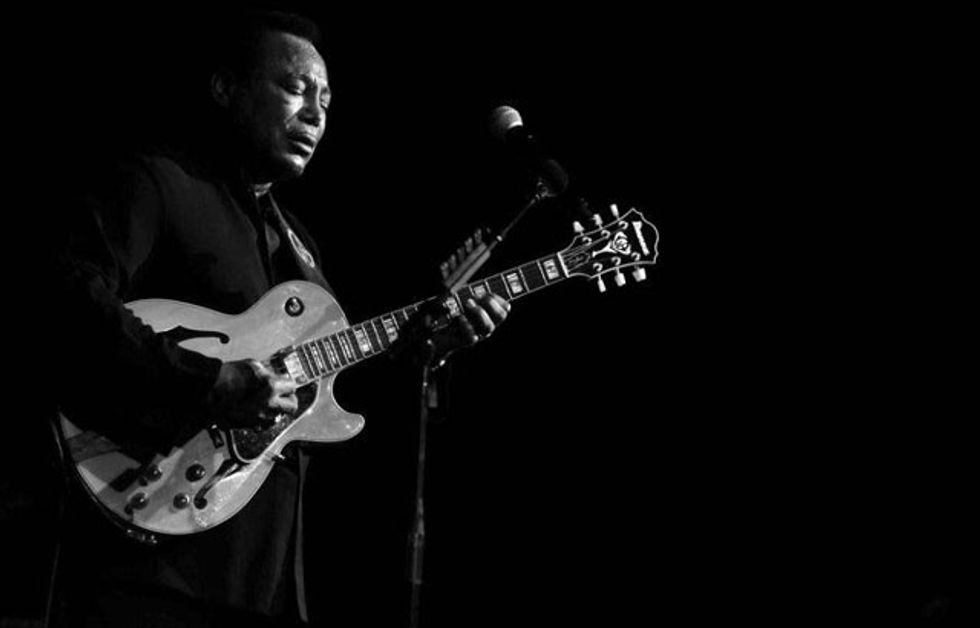 Photo by John Darwin Kurc
Photo by John Darwin KurcHow about amps?
I use two Fender Twins. I used
to use Polytone Mini-Brutes.
Although I love the tone—it’s
one of my favorite sounds for
guitar and works great in the studio—
I found that, in big places,
it wasn’t fast enough. It didn’t
give me instant sound. Now I’m
working with Fender and we’re
designing a new amplifier.
When is this coming out?
It’ll be out next year. We’re still
working on it now.
Will it be tube or solid-state?
That’s one thing we’re working
out. I lean toward the tubes,
because the sound is so much
more incredible. But I’m not
afraid to try solid-state.
Do you think the signature
amp will have a distortion
channel?
Man ... [laughs] I usually use
clean. But you did say something
important, though … I
better not take that feature out
of my new amp.
Guitar Man starts off with
“Tenderly,” which you also
recorded on the 1989 album
of the same name. Both are
solo-guitar renditions, but the
older version was a minute
longer and a bit flashier than
this new one.
I was trying to prove a point
[on the first one], like, “Here’s
what I can do.” I love that version,
because I surprised myself
on it. I was like, “Man, is that
me playing that?” But it wasn’t
very tender. This version recaptures
the romantic side of that
wonderful song. I was trying
to do a more romantic version
based on the Johnny Smith version.
He’s one of my favorite
players. Wes and I used to talk
about him all the time—how
beautifully he played and the
tuning down to D, which he
made popular back then.
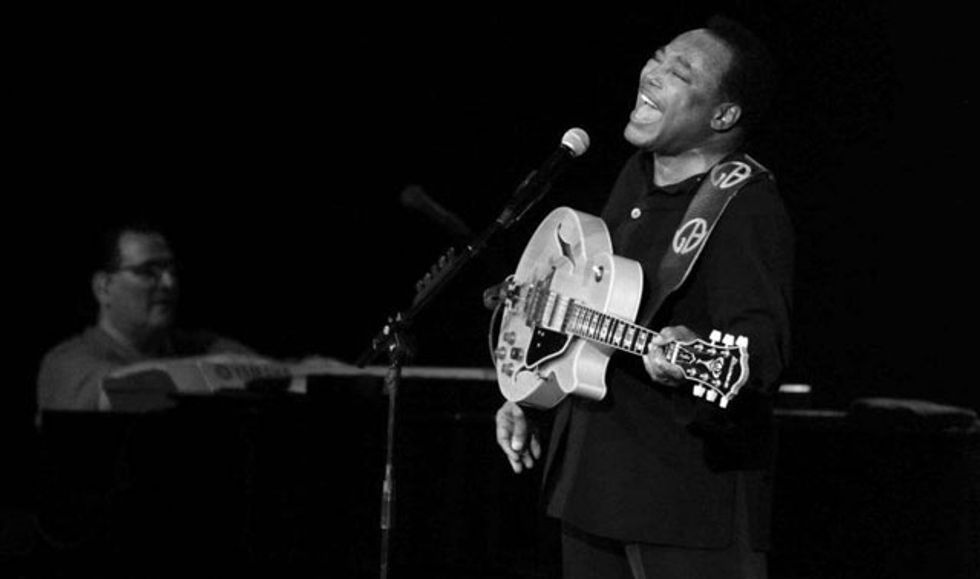 Photo by John Darwin Kurc
Photo by John Darwin KurcWhen you tune down to D
and play the fast runs, do
you adjust your fingerings for
notes on the low E string or
do you just avoid that string?
If you make a mistake, baby,
you’re in the wrong place
[laughs]. It really doesn’t upset
the harmony too much, but you
turn a major chord into a blues
chord if you don’t watch it.
What prompted you to
record Stevie Wonder’s “My
Cherie Amour”?
I did it because I promised
Stevie I would. He had heard
me sing it once and he said,
“You gotta record that George.
You must record that.” I kept
my promise.
Guitar Man also features pop
songs like “The Lady in My
Life” and “Don’t Know Why.”
Pat Metheny also recorded
“Don’t Know Why” on his
2003 album One Quiet Night.
Are today’s pop songs becoming
the new standards?
Well, that’s the way they’ve
always done it. Miles Davis
did it. He used to do “Autumn
Leaves.” That wasn’t a jazz tune,
it was a pop song. When jazz
people do it, it takes on a whole
new meaning, different colors.
Sometimes they’ll reharmonize,
which really gives a lift to a
song that’s been overplayed.
Was “My One and Only
Love” inspired by the Johnny
Hartman/John Coltrane version?
Oh, definitely. That will always
remain an outstanding version
of that song and performance,
period. It was hard for me
to think about recording it,
because I didn’t want people to
think that we were stepping on
the toes of that version. I wanted
to pay homage to it, and I
think we did a decent job.
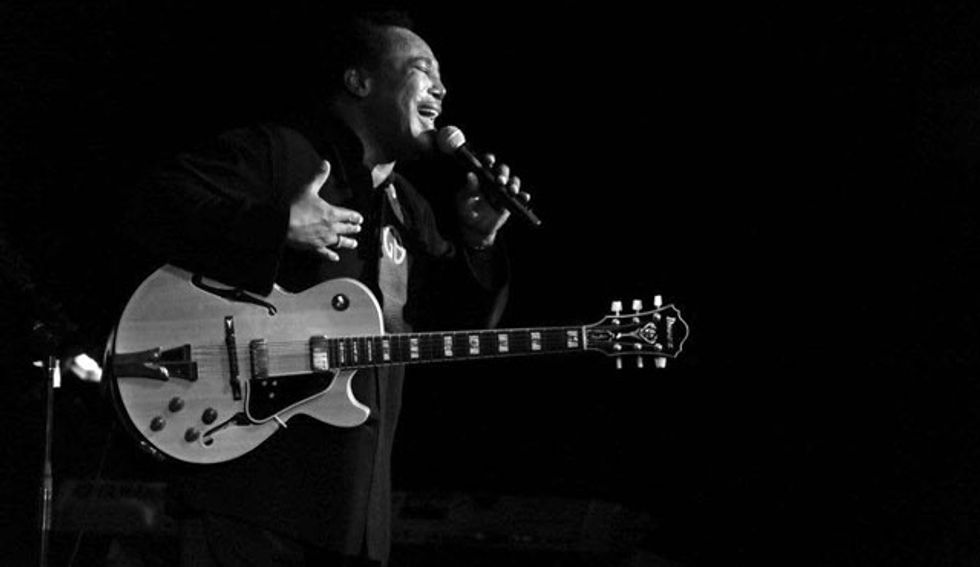 Photo by John Darwin Kurc
Photo by John Darwin KurcOn “Paper Moon,” your solo
starts off with some bending—
which isn’t often heard in a
straight-ahead jazz context.
Why do traditional jazz players
typically avoid bending notes?
If you remember, Charlie
Christian used to bend notes—
and he was the swingin’-est
cat there was, man! So I’m
not afraid. I think people are
used to hearing that in modern
music. You know, B.B. King
and all the other cats do it.
Rock players do it. I’m not
afraid to let jazz have a shot at
it again, too, since we started it.
Tell us about “Danny Boy.”
Well, first of all, I’ve got Irish
and Welsh blood in me. My
grandfather told me, “Yeah,
yeah, boy, you’re Irish and
Welsh.” That was my attempt
at creating some bagpipes, or
at least the vibe from bagpipes.
It worked very well because,
with some audiences, we see
people with tears in their eyes.
They must be Irish or Scottish
[laughs]. And when we play
in Ireland, people love us over
there. I played “Danny Boy”
over there for the first time a
few years ago, and I couldn’t
believe the response I got. It
was the best song in the show.
Mike Stern once told me,
“George Benson is the best
jazz guitar player alive.” Even
though you’re essentially a
pop star, this seems to be the
general consensus among
jazz guitarists.
Mike Stern’s a good cat, man. I
love him. I remember when he
came to New York, my manager
said, “Man, there’s a kid
in town—you gotta hear him
play.” So we went down and it
was Mike Stern. He bounced
off the wall—he took all the
paint off the wall in the place
that night! So I knew we had a
new star on our hands. He’s a
wonderful cat and he plays the
crap out of the guitar. You can’t
ask for more than that.
But Tal Farlow started it. They asked him who his favorite guitar player was, and he said, “George Benson,” and they said, “Why do you say that?” Because at the time, I was a pop artist and the kids didn’t like the fact that I was getting credit as a guitar player. And Tal Farlow said, “I like him because every time I hear him, he’s playing something new.” I think people like the fact that I keep coming up with new ideas—and they don’t have to be big ideas. Guitar players, they know. Once they hear you, they know your sound. When you play a lick, they know it’s you. “Man this sounds like George Benson, but I’ve never heard him play that before.” And that’s because I practice virtually every day. Still do.
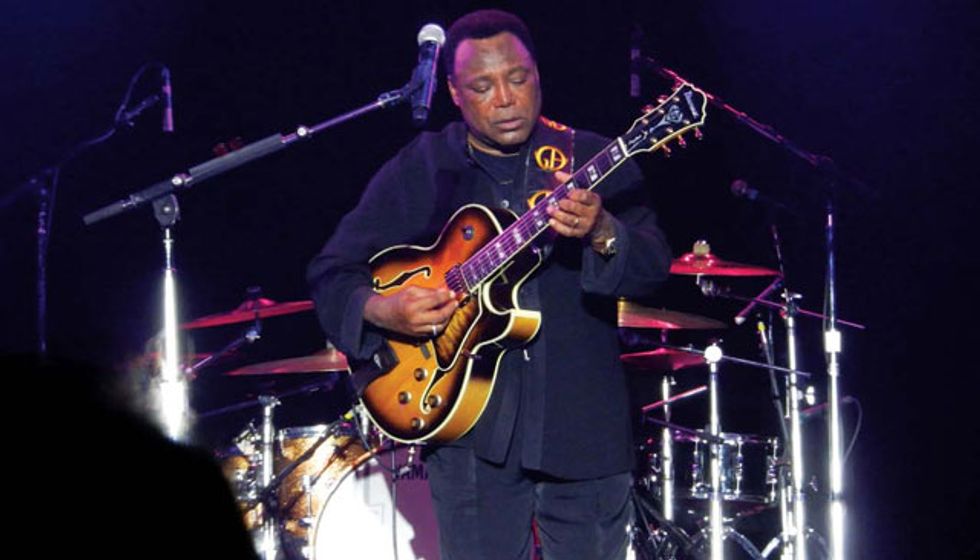 Photo by Jerry L. Neff
Photo by Jerry L. NeffWhat kind of stuff do you
work on now?
Ideas mostly, things that people
have not heard. Like that thing
we did with “Danny Boy.” I
worked on that for a long time
before I got enough nerve to
bring it out. I’ve got a lot of different
formulas, and I use them
whenever they seem to fit. Say, for
instance, my solo on “Tequila.”
I started off playing nothing but
basic triads with an octave on top.
As simple as it sounds, in certain
circumstances it works very well.
Your technique is phenomenal.
In the beginning, what did
you work on to get it to such a
high level?
When I got to New York and
found all these guys with all this
fabulous technique—Pat Martino
and Grant Green and a few others—
I said, “Man, I’m not gonna
be able to make it here.” I knew
I couldn’t match those guys. So I
started devising my own method
and reexamined the fingerboard.
If you play a standard guitar,
where you’re playing across the
fingerboard, you’re playing down
the fingerboard instead of going
up. If I move my hands in the
direction, slide them up as I
play the notes, then it’s a logical
progression. That kind of thing.
I had to examine that over and
over again until I got it right. I’m
moving in the direction that the
sound is suggesting. It’s all about
getting from point A to point B.
So I said, “Well, let me try it this
way.” And I said, “Whoa! This
is much simpler—and I can be
much more accurate if I do it
this way.”
Musicians are also in awe of
your seemingly flawless sense
of time. Did you always have
that, or did you have to work
on it?
I listened to Charlie Christian
with the Benny Goodman
band. Benny Goodman rightfully
had the name “King
of Swing.” There were other
cats who could swing, but he
consistently swung and he
had good cats in the band. I
listened to that and realized
that I should loosen up a little
bit, leave myself room where
I could pick up some extra
things. Leave a note out here
and pick it up later over here—
add it to the swing. I began to
do it until it became natural,
and it’s followed me down
through the years.
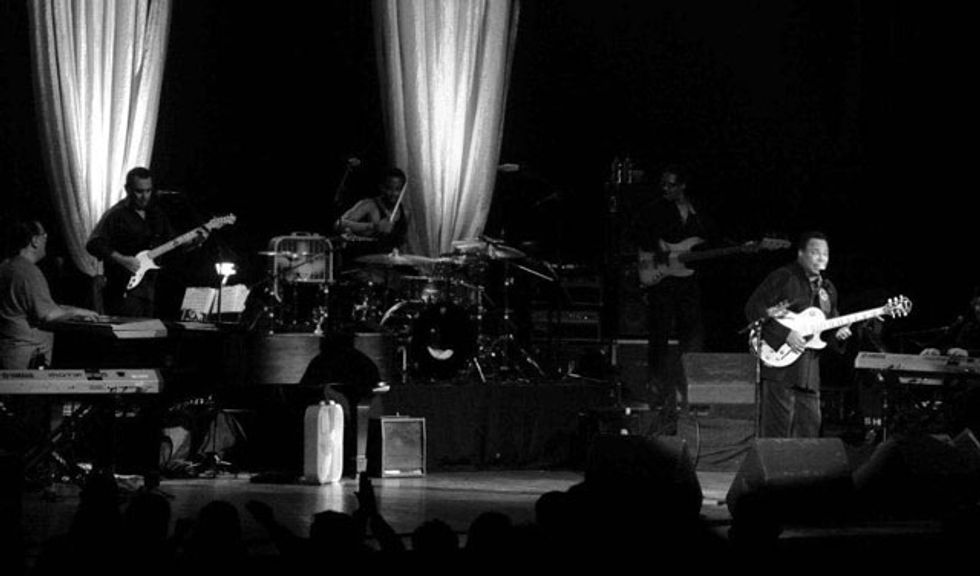 Photo by John Darwin Kurc
Photo by John Darwin KurcWhat advice would you give
to players who want to develop
a stronger sense of time?
For example, some people recommend
using a metronome,
and others are completely
against it.
No, some people need that.
So it depends on the individual?
Yeah, well Montgomery used
it—I have the one that he used!
When I first saw him with that
metronome years ago, I said,
“Wow, Montgomery uses a
metronome! Is that why he’s so
good? Maybe I better get me a
metronome.” But I never used it.
I have a good sense of rhythm.
Your single-note playing is fairly
staccato, as opposed to, say,
Pat Metheny’s, which is very
legato. Is that something you do
intentionally? And if so, why?
I did it because my favorite
players play like that. Hank
Garland, he had a very staccatoy
sound. It made it sound
more forceful [scats staccato-ish
phrase]. It was like, “Wow, it’s
like the notes are dancing in
front of me!” I don’t have a lot
of pressure in my left hand, I
never did. I think it came from
playing cheap guitars where the
winding would come undone
on the strings and it would cut
my fingers. So I stopped pressing
hard. I play very light in my
left hand. Django, in order to
get the vibrato, had to have a
lot of pressure in his left hand.
Pat Martino has a lot of pressure
in his left hand.
You hold your pick at an
unconventional angle. Is there
an advantage to that?
There are advantages and disadvantages to every technique
I’ve seen. The technique that I
have lends itself toward playing
phrases that are not based in
numbers—y’know, eighth-notes,
16th-notes. It’s not based on
that. I’m leaving myself open so
I can change from quarter-notes
or eighth-notes and stick some
fast triplets in there. Instead of
playing four notes, if I play triplets
I get 12 [scats a triplet-infused
phrase]. But if you play with
standard technique—if you get
used to playing quarter-notes,
eighth-notes, 16th-notes, 32ndnotes,
whatever it is—you get
used to this [scats a fast phrase in
steady eighths], and after a while
that bores me. So the technique
I’m using—which isn’t the greatest,
don’t get me wrong—makes
it so I can play those phrases
and still be within the realm
of playing the single lines with
the quarter-notes or the even
eighth-notes.
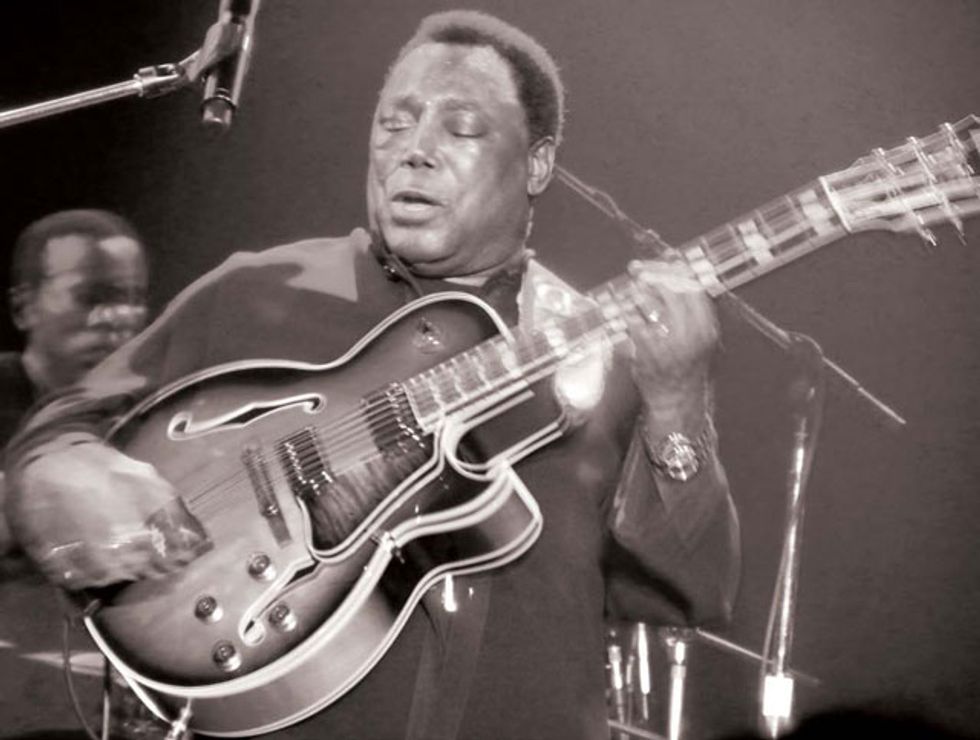 Photo by Jerry L. Neff
Photo by Jerry L. NeffI imagine this technique is
fairly dependent on specific
picks or gauges, then.
I use medium picks. They’re not
too stiff and they allow me to
have better rhythm. And the two
edges [on mine] come down to a
point that’s straighter than on a
Fender pick. I do that because it
gives me much more snap when
the pick comes off the string.
Do you usually pick every
note, or do you integrate
hammer-ons and pull-offs
or sweep-picking in your
speedier lines?
There was a period when I
picked every note, but I find
that it’s not necessary in the
way I’m thinking now—I’m
beginning to let up on that.
As you get older, you don’t get
into the particulars so much
as you do when you’re trying
to speak a language. So I don’t
force that anymore. Kenny
Burrell asked me that once,
“George, are you picking every
note?” I said, “I don’t know—
I guess so, Kenny.” And he
was the master of the guitar.
He and Wes Montgomery
dominated the jazz world at the
time. So for him to ask me any
question about the guitar was
phenomenal.
George Benson's Gear
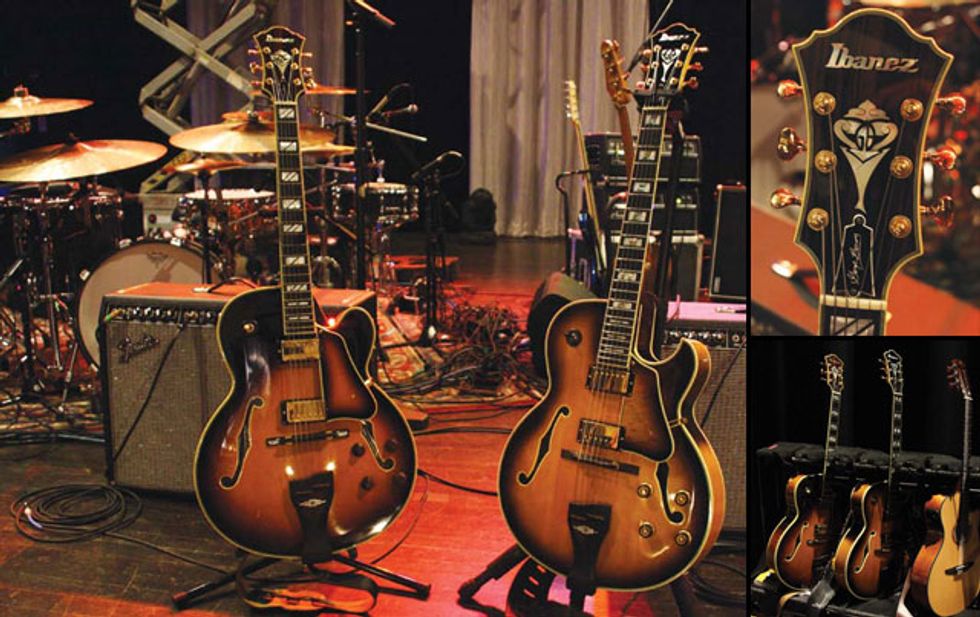 Top Right: Benson’s signature Ibanez hollowbodies
feature ornate, vintage-style headstock
inlays. Photo by John Mooy. Bottom Right: On his current tour, Benson has a guitar boat with two signature
Ibanez hollowbodies and a Yamaha nylon-string.
Photo by John Mooy. Left: Two of Benson’s Ibanez signature models—a GB200 (left) and a prototype of the upcoming LGB (Little Georgie Benson)—onstage with a pair of Fender
’65 Twin reissues mic’d with a large-diaphragm Shure condenser. Photo by John Mooy.
Top Right: Benson’s signature Ibanez hollowbodies
feature ornate, vintage-style headstock
inlays. Photo by John Mooy. Bottom Right: On his current tour, Benson has a guitar boat with two signature
Ibanez hollowbodies and a Yamaha nylon-string.
Photo by John Mooy. Left: Two of Benson’s Ibanez signature models—a GB200 (left) and a prototype of the upcoming LGB (Little Georgie Benson)—onstage with a pair of Fender
’65 Twin reissues mic’d with a large-diaphragm Shure condenser. Photo by John Mooy.Guitars
Ibanez LGB prototype,
Ibanez GB30, Yamaha
nylon-string, Cordoba
nylon-string
Amps
Two Fender 1965 Twin
Reverb reissues
Strings, Picks, and Accessories
Thomastik-Infeld George
Benson Signature .012s
(live) and .014s (studio),
Ibanez George Benson
mediums picks, Monster
Cable, Radial JDI Passive
Direct Box
Youtube It
For a taste of George Benson in action, check out
the following clips on YouTube.com.
Benson scat sings with Dizzy Gillespie,
then takes a jaw-dropping guitar solo
(from 7:48–8:58) that will make you
want to quit the guitar.
This rare clip shows Benson in a lessformal
setting, playing Miles Davis’ “So
What” with a killer band featuring drummer
Jeff “Tain” Watts and other notable
musicians. His killer solo starts at 5:25 and
features nearly three minutes of fretboardmelting
modal madness.
Benson makes his guitar sound like bagpipes
on this solo rendition of “Danny
Boy.” In addition to the chordal mastery
on display here, check out how Benson
articulates even the quickest of single-note
runs with his right-hand thumb—particularly
in the cadenza (3:00–3:08).




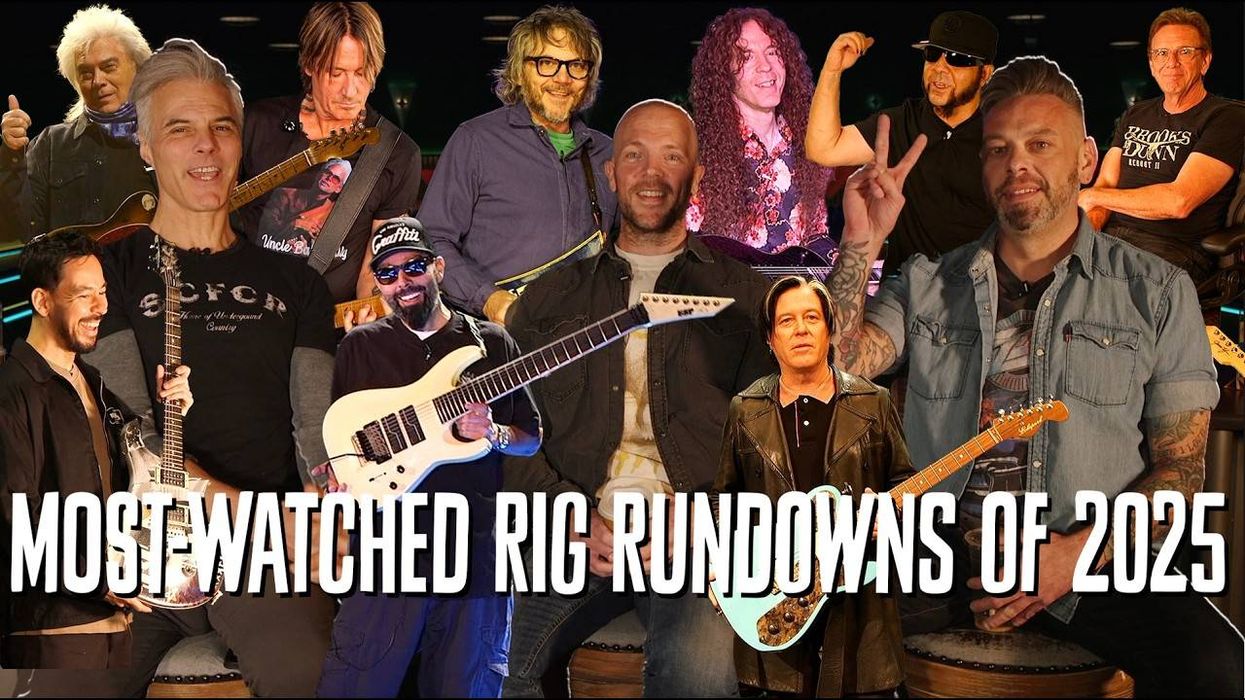
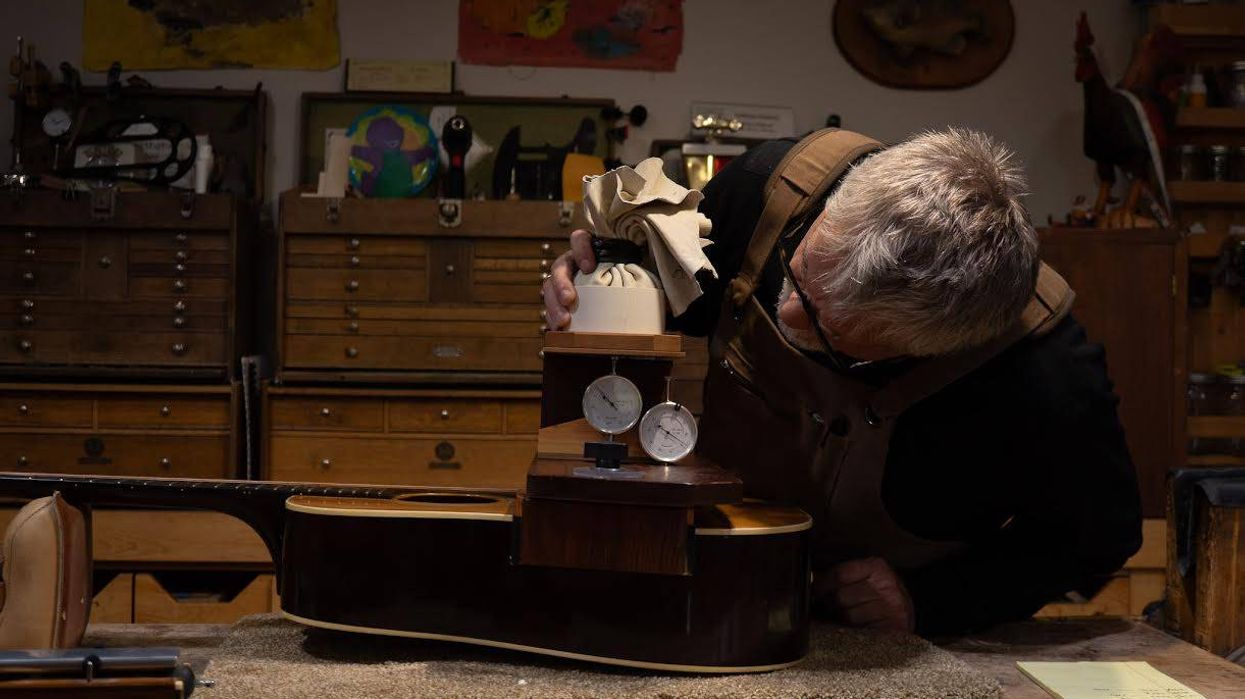











![Rig Rundown: Russian Circles’ Mike Sullivan [2025]](https://www.premierguitar.com/media-library/youtube.jpg?id=62303631&width=1245&height=700&quality=70&coordinates=0%2C0%2C0%2C0)








